Dark, Moody Kitchens Are the Next Big Style
Deep hues, warm woods, and rich textures define the cozy look.
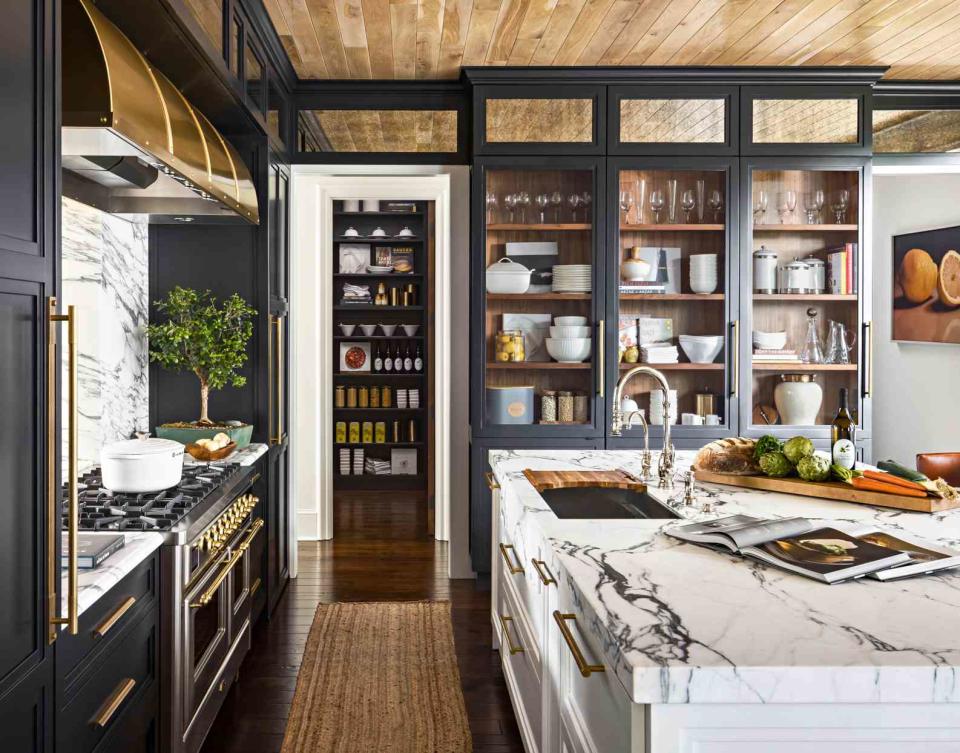
Move over, all-white kitchens. Although these bright spaces remain a classic color choice, designers say there’s a definite shift toward darker, moodier kitchens. In fact, according to a just-released 2023 trends report by the National Kitchen and Bath Association (NKBA), “moody” is expected to be one of the top three most-popular tones for kitchen design in the immediate future.
The cause of this kitchen color shift is simple—homeowners are ready for something different. “The white kitchen has dominated the market, at all price points, beyond its prime,” says Ellen Lopez, founder and creative director at EL Design Studio. Incorporating color is a trend expected to take off throughout the home, and the kitchen is at the center of it all. “The kitchen signifies a place for everyone to gather, and the idea of dark and moody to me also translates as warm, cozy, and togetherness,” says Nureed Saeed, owner and creative director of Nu Interiors. “It’s not surprising that people want to feel warmth in the place they spend the most time.”
We asked four NKBA-certified designers why this style is on the rise and how to nail the luxe look.
How to Get a Moody Kitchen
“Dark kitchens are all about luxury and quiet comfort,” says Crystal Hackl, the designer behind Inspired Haven Design. “Think deep, rich painted cabinetry, natural stone countertops, luxe gold tones, and clean horizontal lines.” Mix in warm woods and plenty of texture, and you’re set for a dreamy kitchen. Here’s how to pull off the look so your space feels fresh and inviting rather than gloomy.
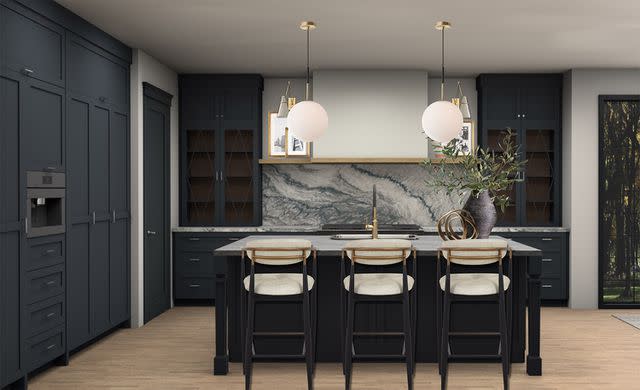
Inspired Haven Design
1. Dark Cabinets
Start with a dark foundation, says Lauren Schulte, owner of Monarch Kitchen Design Studio. “Choose a deep color, whether it is a heavy forest green, dark navy, charcoal, or black,” says Schulte. Greens and blues are already popular kitchen colors, and they make a rich, earthy choice when used in a darker hue. The strong color should definitely be used on base cabinets, but Schulte says applying dark shades to both base and upper cabinets will have the biggest impact. Walls can use a similar tone for depth and drama.
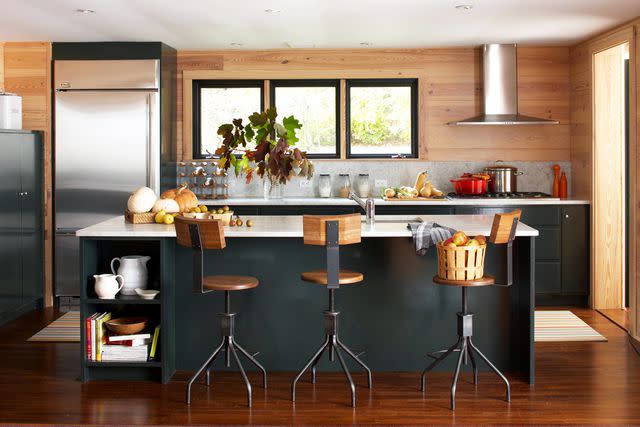
2. Natural Elements
Wood, stone, and earthy colors are a must for this look. “A dark kitchen can feel very intimate and calming and grounding, particularly if it uses colors found in nature and plenty of natural elements,” says Hackl. All the designers agreed, identifying wood and stone as key natural elements complementing the warm, dark blues, greens, and blacks prominent in the moody aesthetic.
Look for ways to incorporate warm woods, like walnut and oak, through floating shelves, tables, barstools, ceilings, or other accents. Natural stone and stone-look countertops, flooring, and backsplashes are another option. Marble and quartzite are two popular suggestions, particularly because they offer “movement and drama” to a space, according to Hackl.
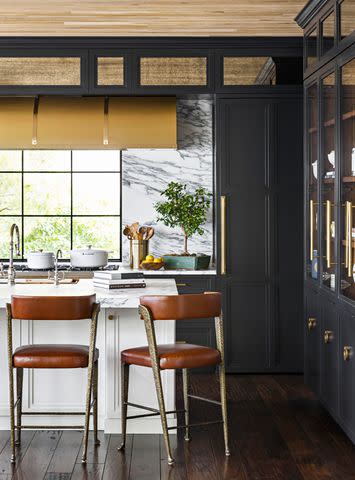
3. Light Surfaces
“The key to pulling off a dark kitchen is layering and balancing dark tones with lighter elements,” says Hackl. How many light surfaces are used in a kitchen varies; the more dark surfaces, the moodier and more dramatic the space. If you’re committing to dark cabinets and walls, try lightening up at least one of the other main surfaces. “In most traditional dark moody kitchens, the countertops are light and airy,” says Lopez. “Since the surface is horizontal, the light countertop reflects the light; this softens the mood.”

4. Metallic Accents
“Oftentimes when you see moody styled kitchens, the glamour in the room is in elements of metal,” says Schulte. Much like light countertops or other surfaces, metallics offer visual relief from dark colors. "Since the look is very rich, there needs to be a resting place for the eye, particularly in a monochromatic space where the walls, cabinets, counters, and ceilings are nearly the same color,” says Schulte. “The best way to highlight it is through bold accents, whether it be the hardware or a heavy gold frame, light fixtures, a beautiful faucet, or even just the bowls that sit on the counter.” But these grounding elements don’t have to be metallic: light wood accents, white apron-front sinks, and other elements that pop against the dark backdrop can do the trick.
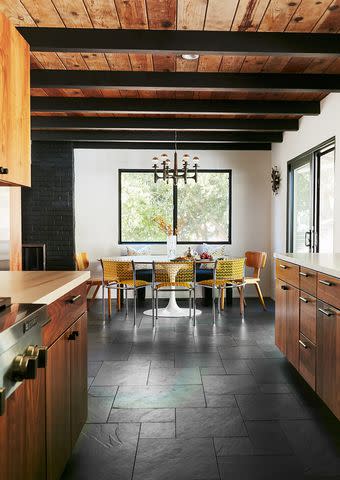
Nu Interiors
5. Varied Textures and Tones
“The main thing with this look is to not confuse dark and moody with monochromatic or lack of detail and interest,” says Saeed. Although moody kitchens aren’t exactly colorful, they're certainly not monotone. Even if monochromatic, the best dark, moody kitchens use varying shades and textures for depth. “Choosing shades or tones and texture within a color range is key to making the look work while not looking one-note,” says Saeed. If you’re sticking with a dominant color, look for ways to vary it. “Tile with 3D reliefs or texture also work well to create dimension and help bring interest to the space,” says Saeed.
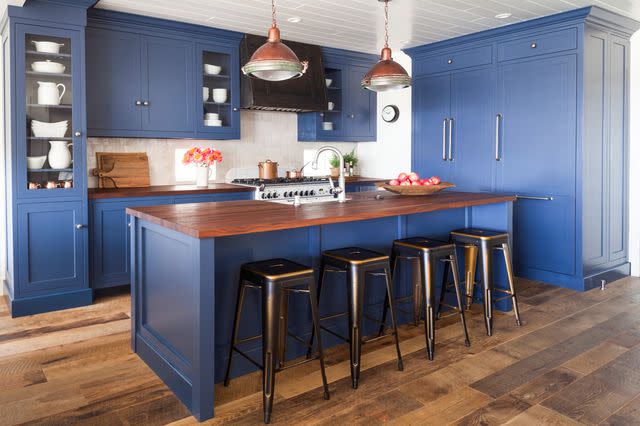
6. Hidden Appliances
“This look is a distinct departure from the white kitchens that have had a long moment in the spotlight. It’s a reflection of the kitchen’s growing role as a living space, one that feels less like a kitchen and more like an extension of the social spaces in the home," says Hackl. Minimizing the presence of appliances is one way this aesthetic is developing. According to Hackl, appliances should be concealed with paneled fronts, and the range hood camouflaged with something like stone, wood, or plaster so that it blends with the rest of the kitchen. Countertop appliances should be tucked away inside cabinets or located in a pantry.
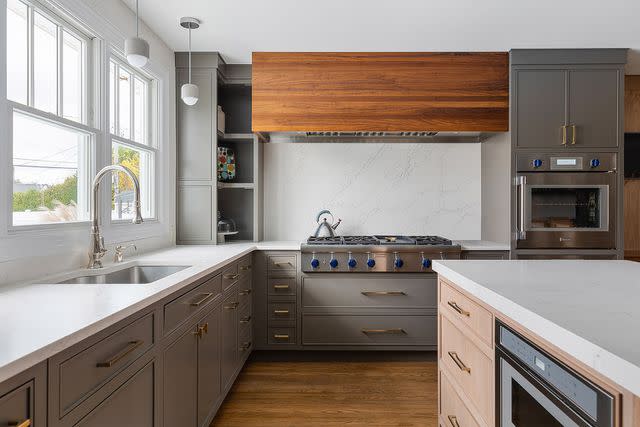
EL Design Studio
7. Clean Lines
Although most of the design elements key to moody kitchens can be applied to any design style, the pros agree that the clean horizontal lines of modern and transitional styles are an ideal canvas. The stones and woods common in midcentury design are also perfect complements. You might find that the color balance in a moody kitchen is one way to make this look lean more contemporary or more traditional. “I’ve noticed that the modern kitchen is usually paired with darker countertops while the traditional and transitional kitchen is paired with the light, marble-like tops,” says Lopez.
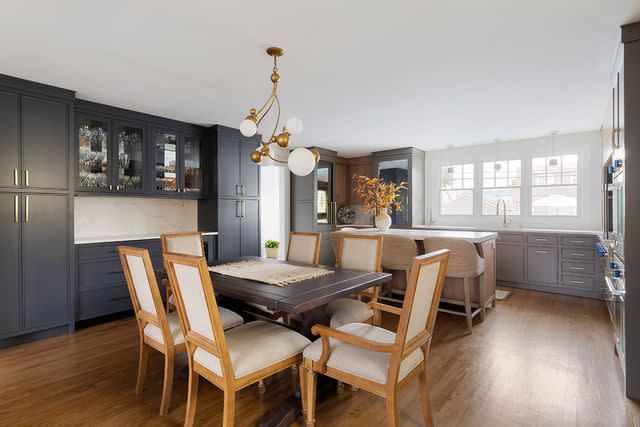
EL Design Studio
8. Good Lighting
Lighting is imperative for safety and functionality in every kitchen, but it’s especially important in a kitchen with many dark surfaces. You’ll need the usual artificial kitchen lighting, as well as an abundance of natural light, which provides the warm glow that supports the moody aesthetic. “In addition to the natural light, I like to incorporate a decorative mirror,” says Lopez. “The mirror visually expands the space and acts to reflect the light and color.”
false

